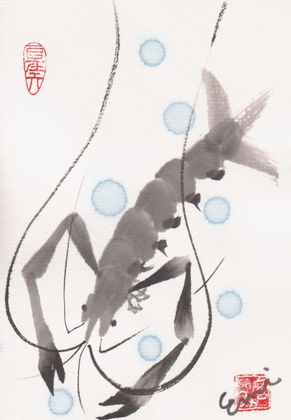Brewery #2 Hamada Shuzo – Shochu Distillery
Our Sake Master, Andre, continues on with his wonderful sake brewery tour in Japan. Our destination this time is Kagoshima!
I’m hurtling south on the Shinkazen, Horibuchi San and I are enjoying the plush splendour of the new “Sakura” Shinkansen service to the far south west of Japan, Kagoshima – Shochu Country. Our destination is Hamada Shuzo, one of Kagoshima’s main producers of Shochu and in particular, famous for their Imo (Sweet Potato) Shochu called Kaido.

Kurabito (brewery worker) stirring shochu
The distinctive Red Kaido bottle already graces the shelves of many good Australian bars. The Red bottles itself stands for “Celebration” and represents the setting sun. Mr. Yuichiro Hamada the President of Hamada Shuzo also explains that the name Kaido has a deeper meaning. In 1865, 19 feudal warriors from the Satsuma region went to Europe to study how to set Japan on its way to becoming a modern nation. At that time, Japan was a closed country and the government did not allow its’ citizens to travel abroad. These brave warriors went to Europe at the risk of losing their lives. Kaido honours and celebrates that achievement.
There are approximately 600 shochu distilleries in Kyushu, 111 are in the Kagoshima prefecture. Hamada Shuzo produces around 10 different styles of shochu but here in Australia you are most likely to come across the Kaido (sweet potato), Kakushigura (barley) and Shironotakumi (rice) brands. Shochu is usually bottled at 25% abv but you can find stronger.

The family photo of Hamada Shuzo (second generation)
In short the history of Shochu is believed to have started around the mid 1500’s. Distillation knowhow hit Japan in the north, originating in Persia (as Arak) and crept east through India and China. In the south it came from Thailand, up through Okinawa (as Awamori) and into Kyushu around the mid 1600’s. Shochu has enjoyed highs and lows in popularity amongst Japanese drinkers. Originally seen as the drink of choice for old men, it has worked wonders in changing its image. The first Shochu boom was during the 80’s and the second wave hit in the early 2000’s. In fact in 2003 Shochu sales surpassed Sake for the first time in history. The rising popularity of Shochu has also prompted the distilleries to focus on premium quality product specialising in various degrees of aging and small batch runs.
Shochu can be produced using both single (otsurui shochu) and multiple distillation (korui shochu). Single distillation is recognized as the premium production method, allowing the character of the raw ingredient to shine through. To differentiate it from its inferior brother korui, this premium style is often referred to as Honkaku Shochu or “authentic” shochu.
To be continued…
………………………………………………………………………………………………………………………………………………………………………
 Andre Bishop is a Melbourne based Sake Professional and is recognized as one of Australia’s leading authorities on Sake. His 12 years of experience in designing Asian and specifically Japanese venues include well know Melbourne establishments Robot Bar and Golden Monkey. He currently owns the 22 year old Japanese dining institution Izakaya Chuji and Sake Bar Nihonshu. He is also co-owner and founder of Melbourne’s flagship Izakaya and Sake Bar, Kumo in Brunswick East. Andre studied Sake in Japan and is the only Australian who currently holds a Level 2 Sake Professional Certificate from the International Sake Education Council.
Andre Bishop is a Melbourne based Sake Professional and is recognized as one of Australia’s leading authorities on Sake. His 12 years of experience in designing Asian and specifically Japanese venues include well know Melbourne establishments Robot Bar and Golden Monkey. He currently owns the 22 year old Japanese dining institution Izakaya Chuji and Sake Bar Nihonshu. He is also co-owner and founder of Melbourne’s flagship Izakaya and Sake Bar, Kumo in Brunswick East. Andre studied Sake in Japan and is the only Australian who currently holds a Level 2 Sake Professional Certificate from the International Sake Education Council.
Andre is available for Consulting on Sake, Japanese Beverage Lists, Sake Staff Training and Sake Equipment. Contact: [email protected]
Sake Master Andre’s blog: www.sakemaster.com.au
Twitter: sakemasterandre
Sipping with the Sake Master #5.2
Sipping with the Sake Master #5.1
Sipping with the Sake Master #4
Sipping with the Sake Master #3
Sipping with the Sake Master #2
Sipping with the Sake Master #1
Please click here for Sake Master Andre Bishop’s older interview



